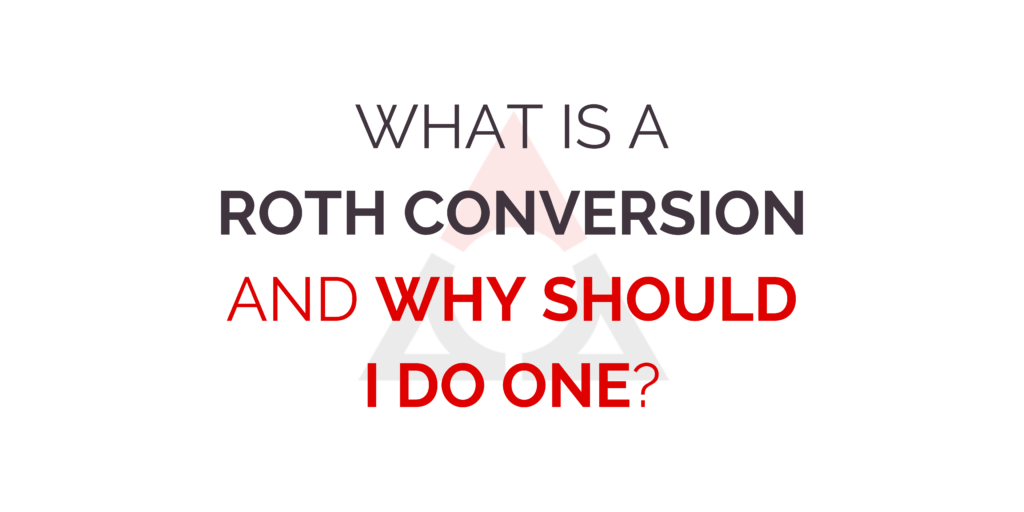Retirement Account Types
When saving in a retirement account an investor has two options, to save money pre-tax or Roth.
Pre-tax savings result in a tax deduction of the amount contributed each year (assuming you are not over any applicable income limits), tax-deferred growth of the investments, and an income tax bill each year as the assets are withdrawn in retirement.
When an investor saves money into a Roth account they do not get the tax deduction on the funds they contribute and as long as applicable holding requirements are met the funds are tax free whenever withdrawn.
What is a Roth Conversion?
A Roth conversion is completed when an investor chooses to move funds from their pre-tax account – like a Traditional IRA – into their Roth account – like a Roth IRA. In exchange for doing so the investor elects to intentionally pay taxes in the year of the conversion at whatever their tax rate is for that given year.
Example: John and Jane have a taxable income in 2024 of $130,000 putting them in the 22% tax bracket. They decide to convert $50,000 from their Traditional IRA to their Roth IRA. Considering the upper limit for the 22% bracket in 2024 is $201,050, the full $50,000 conversion will be taxed at the 22% rate leading to a tax bill of $11,000 to complete the conversion. To make the conversion as tax-efficient as possible and to ensure the maximum compounding of their Roth IRA, John and Jane will pay the tax bill from their taxable money instead of withholding some of the converted funds.
Why would an investor want to complete a Roth conversion?
They are in a lower tax bracket than they typically would be
The math behind a Roth conversion is such that you come out ahead if you can intentionally pay taxes at a lower rate than you might otherwise have to pay. If someone anticipates a substantial increase in income in the future – for example someone who recently received a major raise – or is having a low income year – someone who was between jobs for a portion of the year – can take advantage of the lower tax rate by converting assets to Roth.
Example: Marvin was named partner at his law firm in November of 2024 and with the promotion comes a substantial expected raise in income that will persist for the remainder of his career. As a married individual making $250,000 per year he was in the 24% tax rate. With his promotion he expects to make over $600,000 per year – which will put him in the 35% tax rate. With an upper limit on the 24% tax rate of $383,900, Marvin can convert $163,100 of his IRA to Roth and have the full amount taxed at the 24% rate, assuming he takes the standard deduction.
They believe tax rates will rise in the future
The likelihood that tax rates will rise in the future is another reason an investor may believe that they are in a lower tax rate now than they will be in the future. With the the Tax Cuts and Jobs Act (TCJA) set to sunset after 2025 there is a chance that investors making the same amount of money could find themselves in a higher tax bracket. A tax savvy strategy to utilize the current low tax rates would be to convert assets now in anticipation of higher rates in the future.
Example: John and Jane have a combined taxable income of $250,000 and anticipate earning a similar income for many years in the future. In 2024, that level of income would fall in the 24% bracket while if we assume the current tax rates sunset to pre-TCJA rates after 2025 the same taxable income would land them in the 33% bracket. John and Jane can convert up to the top of the 24% bracket (up to $116,000 per year) to lock-in the lower tax rate.
They previously retired and are in the tax planning window
Many retirees have a window after retirement and before they claim social security and must begin taking RMD’s where their income is substantially lower than it has been previously and will be in the future for a handful of years. By converting funds to Roth, they both complete a tax rate arbitrage and also reduce future RMD’s and protect their beneficiaries from potentially substantial increases in taxable income brought about by the SECURE Act’s 10-year rule.
Example: Jerry retired at the age of 62 and while living off roughly $120,000 per year he has taxable assets to support his lifestyle until he begins Social Security at age 70 and begins taking RMD’s at age 73 meaning he will be in an artificially low tax bracket for the next 8-10 years. His RMD projections indicate that he will be required to withdraw significantly more than needed and his only child is a high earner who will be severely taxed when they ultimately inherit the money and fall subject to the 10-year rule. As such, he elects to convert up to the top of the 22% bracket ($89,075) each year until RMD age to tax-efficiently convert his IRA assets to Roth to help address his concerns.
They would like to complete backdoor Roth contributions in the future
In order to contribute to a Roth IRA in 2024 you must be below the income limit – the phaseout begins at $146,000 for single filers and $230,000 if married filing jointly. Tax savvy savers will utilize the backdoor Roth contribution to get around the income limit by contributing to an IRA and subsequently converting the funds to Roth. Due to the pro-rata rules around deductible and non-deductible IRA monies an investor can convert all IRA monies in order to utilize this savings technique each year.
Example: Joe has a $35,000 IRA and would like to save $7,000 to a Roth IRA each year moving forward. He earns over $200,000 a year and as a single tax filer is over the income limit to contribute to a Roth IRA or to deduct a Traditional IRA contribution. By utilizing the backdoor Roth contribution strategy, he can make a $7,000 non-deductible contribution to his IRA and convert the full $42,000 in his IRA to Roth. This will allow him to complete the backdoor Roth contribution each year moving forward as well.
They want to tax advantage of a market decline
When the market declines, sophisticated planners find ways to utilize the decline in value in pursuit of long-term goals. One way to do that is to convert assets to Roth at a temporarily depressed value, taking advantage of the lower account value to minimize the tax cost of the conversion.
Example: Jay has a $50,000 IRA that he intends to convert and is in the 24% tax bracket. During the year, the market has a 35% decline as a reaction to an unexpected global pandemic. While many investors panic because of the decline, Jay intends to make sophisticated moves that will benefit him during the temporary decline including converting his IRA – which is now worth $32,500. By converting the IRA during the downturn, he is able to reduce the tax cost of the conversion from $12,000 to $7,800 saving $4,200 on his tax bill.
Check out our latest Cup of Bull episode:
Disclosure: The case studies used are for illustrative purposes only. Individual cases will vary. Any information is not a complete summary or statement of all available data necessary for making an investment decision and does not constitute a recommendation. Prior to making any investment decision, you should consult with your financial advisor about your individual situation.
Any opinions are those of the author and not necessarily those of Raymond James.
Please note, changes in tax laws may occur at any time and could have a substantial impact upon each person’s situation. While we are familiar with the tax provisions of the issues presented herein, as Financial Advisors of RJFS, we are not qualified to render advice on tax or legal matters. You should discuss tax or legal matters with the appropriate professional.
Unless certain criteria are met, Roth IRA owners must be 59½ or older and have held the IRA for five years before tax-free withdrawals are permitted. Additionally, each converted amount may be subject to its own five-year holding period. Converting a traditional IRA into a Roth IRA has tax implications. Investors should consult a tax advisor before deciding to do a conversion.




